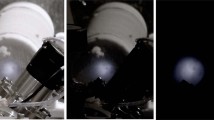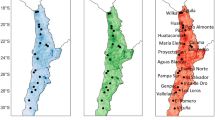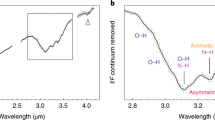Abstract
Low-resolution intensity spectra of Earth’s atmosphere obtained from space reveal strong signatures of life (‘biosignatures’), such as molecular oxygen and methane with abundances far from chemical equilibrium, as well as the presence of a ‘red edge’ (a sharp increase of albedo for wavelengths longer than 700 nm) caused by surface vegetation1. Light passing through the atmosphere is strongly linearly polarized by scattering (from air molecules, aerosols and cloud particles) and by reflection (from oceans and land2). Spectropolarimetric observations of local patches of Earth’s sky light from the ground contain signatures of oxygen, ozone and water, and are used to characterize the properties of clouds and aerosols3,4. When applied to exoplanets, ground-based spectropolarimetry can better constrain properties of atmospheres and surfaces than can standard intensity spectroscopy5,6,7,8,9. Here we report disk-integrated linear polarization spectra of Earthshine, which is sunlight that has been first reflected by Earth and then reflected back to Earth by the Moon10,11,12,13. The observations allow us to determine the fractional contribution of clouds and ocean surface, and are sensitive to visible areas of vegetation as small as 10 per cent. They represent a benchmark for the diagnostics of the atmospheric composition, mean cloud height and surfaces of exoplanets.
This is a preview of subscription content, access via your institution
Access options
Subscribe to this journal
Receive 51 print issues and online access
$199.00 per year
only $3.90 per issue
Buy this article
- Purchase on Springer Link
- Instant access to full article PDF
Prices may be subject to local taxes which are calculated during checkout


Similar content being viewed by others
References
Sagan, C., Thompson, W. R., Carlson, R. & Gurnett, D. &. Hord, C. A search for life on Earth from the Galileo spacecraft. Nature 365, 715–721 (1993)
Coffeen, D. L. Polarization and scattering characteristics in the atmospheres of Earth, Venus, and Jupiter. J. Opt. Soc. Am. 69, 1051–1064 (1979)
Aben, I., Helderman, F., Stam, D. M. & Stammes, P. Spectral fine-structure in the polarization of skylight. Geophys. Res. Lett. 26, 591–594 (1999)
Boesche, E. et al. Polarization of skylight in the O2A band: effects of aerosol properties. Appl. Opt. 47, 3467–3480 (2008)
Stam, D. M. Spectropolarimetric signatures of Earth-like extrasolar planets. Astron. Astrophys. 482, 989–1007 (2008)
Buenzli, E. & Schmid, H. M. A grid of polarization models for Rayleigh scattering planetary atmospheres. Astron. Astrophys. 504, 259–276 (2009)
Keller, C. U. et al. EPOL: the exoplanet polarimeter for EPICS at the E-ELT. Proc. SPIE 7735, 77356G (2010)
Bailey, J. Rainbows, polarization, and the search for habitable planets. Astrobiology 7, 320–332 (2007)
Williams, D. M. & Gaidos, E. Detecting the glint of starlight on the oceans of distant planets. Icarus 195, 927–937 (2008)
Arnold, L., Gillet, S., Lardiere, O., Riaud, P. & Schneider, J. A test for the search for life on extrasolar planets. Looking for the terrestrial vegetation signature in the Earthshine spectrum. Astron. Astrophys. 392, 231–237 (2002)
Woolf, N. J., Smith, P. S., Traub, W. A. & Jucks, K. W. The spectrum of Earthshine: a pale blue dot observed from the ground. Astrophys. J. 574, 430–433 (2002)
Seager, S., Turner, E. L., Schafer, J. & Ford, E. B. Vegetation's red edge: a possible spectroscopic biosignature of extraterrestrial plants. Astrobiology 5, 372–390 (2005)
Montanes-Rodriguez, P., Palle, E., Goode, P. R. & Martin-Torres, F. J. Vegetation signature in the observed globally integrated spectrum of Earth considering simultaneous cloud data: applications for extrasolar planets. Astrophys. J. 651, 544–552 (2006)
Dollfus, A. Études des planètes par la polarisation de leur lumière. Suppléments aux Annales d’Astrophysique 4, 3–114 (1957)
Wolstencroft, R. D. & Breon, F.-M. in Astronomical Polarimetry: Current Status and Future Directions (eds Adamson, A., Aspin, C., Davis, C. J., & Fujiyoshi, T. ) 211–212 (ASP Conf. Ser. Vol. 343, Astronomical Society of the Pacific, 2005)
Appenzeller, I. et al. Successful commissioning of FORS1 — the first optical instrument on the VLT. ESO Messenger 94, 1–6 (1998)
Giovanni portal. http://disc.sci.gsfc.nasa.gov/giovanni/overview/index.html
Pallé, E., Zapatero Osorio, M. R., Barrena, R., Montanes-Rodriguez, P. & Martin, E. L. Earth's transmission spectrum from lunar eclipse observations. Nature 459, 814–816 (2009)
Fox, G. K. et al. Solar system observations by the Wisconsin Ultraviolet Photopolarimeter Experiment — III. The first ultraviolet linear spectropolarimetry of the Moon. Mon. Not. R. Astron. Soc. 298, 303–309 (1998)
Shkuratov, Y. et al. Optical measurements of the Moon as a tool to study its surface. Planet. Space Sci. 59, 1326–1371 (2011)
Goloub, P., Deuze, J. L., Herman, M. & Fouquart, Y. Analysis of the POLDER polarization measurements performed over cloud covers. IEEE Trans. Geosci. Rem. Sens. 32, 78–88 (1994)
Karalidi, T., Stam, D. M. & Hovenier, J. W. Flux and polarisation spectra of water clouds on exoplanets. Astron. Astrophys. 530, A69 (2011)
Kokhanovsky, A., Platnick, S. & King, M. D. in The Remote Sensing of Tropospheric Composition from Space (eds Burrows, J. P. et al.)231–257 (Springer, 2011)
Tinetti, G. et al. Detectability of planetary characteristics in disk-averaged spectra II: synthetic spectra and light-curves of Earth. Astrobiology 6, 881–900 (2006)
Acknowledgements
This Letter is based on data collected with the Very Large Telescope under ESO programme 87.C-0040(A) and (B). E.P. acknowledges support from the Spanish MICIIN, grant CGL2009-10641.
Author information
Authors and Affiliations
Contributions
M.F.S. was the principal investigator of the programme, contributing to observation preparation and execution, data analysis and interpretation, comparison with models, and writing of the manuscript. S.B. was a co-investigator, contributing to observation preparation and execution, data reduction and interpretation, error analysis, comparison with models, and also contributing to the manuscript. E.P. was a co-investigator, contributing to observation preparation, data interpretation, and derivations of actual Earth surface fractions during the observations.
Corresponding author
Ethics declarations
Competing interests
The authors declare no competing financial interests.
Supplementary information
Supplementary Information
This file contains Supplementary Text, Supplementary Figure 1 and legend and Supplementary References. (PDF 153 kb)
PowerPoint slides
Rights and permissions
About this article
Cite this article
Sterzik, M., Bagnulo, S. & Palle, E. Biosignatures as revealed by spectropolarimetry of Earthshine. Nature 483, 64–66 (2012). https://doi.org/10.1038/nature10778
Received:
Accepted:
Published:
Issue Date:
DOI: https://doi.org/10.1038/nature10778
This article is cited by
-
Computational spectropolarimetry with a tunable liquid crystal metasurface
eLight (2022)
-
Passive broadband full Stokes polarimeter using a Fresnel cone
Scientific Reports (2019)
-
Flux and polarization signals of Earth-like exoplanets covered by sub-solar clouds
Astrophysics and Space Science (2019)
Comments
By submitting a comment you agree to abide by our Terms and Community Guidelines. If you find something abusive or that does not comply with our terms or guidelines please flag it as inappropriate.



